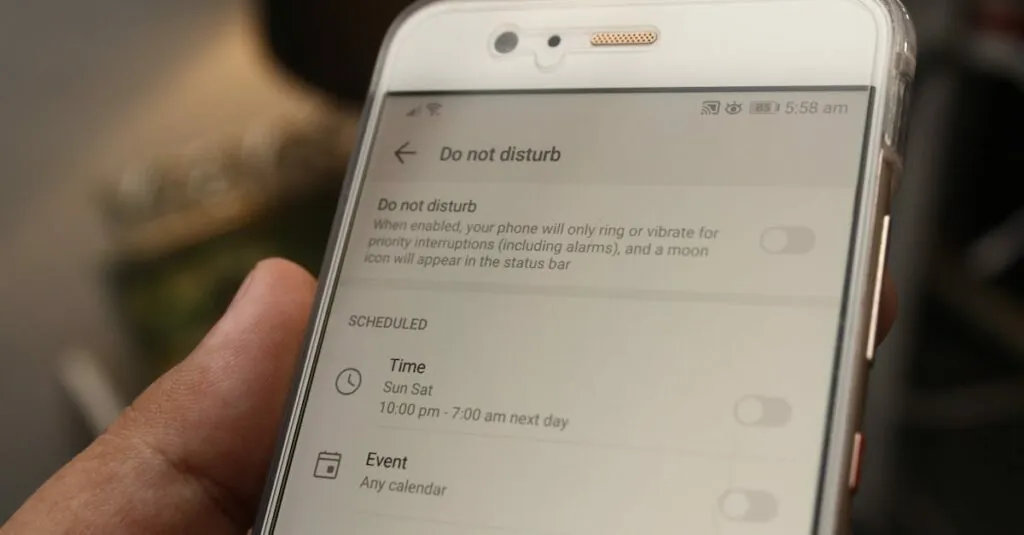Table of Contents
ToggleImagine this: you’re in the middle of a crucial meeting, or perhaps enjoying a peaceful moment of zen, when suddenly your iPhone decides to play the ultimate prank and activates Do Not Disturb. It’s like your phone has a mind of its own, and it’s not afraid to interrupt your life with its mysterious antics. If you’ve ever found yourself scratching your head wondering why your iPhone keeps flipping the Do Not Disturb switch, you’re not alone.
This quirky little feature can be both a blessing and a curse. While it’s designed to shield you from distractions, it can also turn into an unwelcome surprise at the most inconvenient times. Let’s dive into the possible reasons behind this puzzling behavior and discover how to regain control over your notifications without losing your sanity.
Understanding Do Not Disturb Mode
Do Not Disturb mode on an iPhone offers a way to manage distractions effectively. This feature silences incoming calls, alerts, and notifications, allowing users to focus on important tasks.
What Is Do Not Disturb on iPhone?
Do Not Disturb serves as a built-in feature that helps users maintain peace during specific times. It blocks notifications and calls unless they’re from designated contacts, promoting uninterrupted moments. This mode can activate manually or automatically, providing flexibility in managing disturbances.
Common Features and Settings
Common settings within Do Not Disturb allow for tailored user experiences. Users can schedule activation times, creating a routine around meetings or sleep hours. Specific options like allowing calls from favorites or repeated callers add customization for urgent situations. The feature also integrates with Focus modes, enabling synchronized settings for different activities. Understanding these functions assists users in optimizing their notification management.
Possible Reasons for Automatic Activation
Several factors contribute to the unexpected activation of Do Not Disturb on an iPhone. Understanding these reasons can help users maintain better control over their notifications.
Scheduled Do Not Disturb
Scheduled settings may automatically engage Do Not Disturb during specific hours. Users might set this feature for nighttime or meeting times, ensuring minimal interruptions. Checking the scheduled settings can reveal conflicts or unexpected timing, leading to unintended activations. To review these settings, navigate to the “Do Not Disturb” option within the “Focus” settings menu. Adjust the time frames to align more closely with actual usage patterns.
Focus Mode Interference
Focus mode can trigger Do Not Disturb without users realizing it. Various focus settings cater to different activities, like work or personal time. If a focus mode activates automatically, it can silence notifications across the board. Examining focus settings can clarify which modes are currently enabled and how they interact with Do Not Disturb. Reviewing these configurations helps ensure customization meets user preferences.
Software Glitches or Bugs
Software glitches may also cause Do Not Disturb to turn on unexpectedly. Performance issues can result from an outdated iOS version or conflicts with installed apps. Regular updates can minimize these bugs, as developers fix known issues with each release. Restarting the device might resolve temporary glitches. Monitoring updates can prevent recurring problems and enhance overall functionality.
Troubleshooting Steps
Follow these steps to resolve issues with the Do Not Disturb feature activating on an iPhone.
Checking Settings
Check the Do Not Disturb settings in the iPhone’s menu. Access this option by navigating to Settings, then focusing on Sounds & Haptics or Notifications. Disable any scheduling that might trigger the feature during specific hours. Review Focus mode configurations as well, since they can automatically activate Do Not Disturb. Verify that no contacts have special permissions allowing notifications to bypass this mode. Also, ensure that any apps supposed to send notifications are functioning correctly and aren’t blocked.
Restarting Your iPhone
Restarting the iPhone can often fix minor glitches causing Do Not Disturb to turn on unexpectedly. Hold down the power button until the slide to power off option appears. Slide to turn off the device, then wait for about 30 seconds before powering it back on. This simple action resets the phone’s memory and can clear temporary software issues affecting notifications. It’s a quick solution that might restore normal functionality.
Updating iOS
Updating the iOS can resolve bugs that cause features like Do Not Disturb to malfunction. Go to Settings, then tap on General and select Software Update. If an update is available, follow the prompts to install it. Keeping the software current ensures new fixes and improvements are applied. Regular updates help maintain optimal performance and may eliminate issues with unwanted activation of Do Not Disturb.
Preventative Measures
Preventing unexpected activations of Do Not Disturb on an iPhone requires adjustments to settings and awareness of configurations.
Adjusting Focus Modes
Adjusting Focus Modes can greatly improve notification management. Users find that enabling or disabling Focus Modes affects Do Not Disturb behavior. Each Focus Mode can silence notifications differently based on chosen criteria. Turning off Focus Modes helps restore regular notification flow. Users should also customize settings within each Focus Mode to prevent accidental activations. Reviewing these options allows individuals to tailor their notifications according to context. Frequent adjustments can help to mitigate unexpected interruptions during important tasks.
Disabling Scheduled Activations
Disabling scheduled activations may significantly reduce unwanted Do Not Disturb engagements. Users often don’t realize their iPhone has preset times for activating this feature. Checking the Do Not Disturb settings reveals any concealed schedules. Turning off these scheduled times allows users to regain control over their notifications. Examining time slots ensures that important engagements aren’t disrupted by silence. Regularly reviewing these settings can ensure that Do Not Disturb operates only when truly necessary. By staying proactive, individuals can minimize issues related to unwanted activations.
Dealing with unexpected activations of Do Not Disturb on an iPhone can be frustrating. By understanding the settings and configurations that influence this feature users can regain control over their notifications. Regularly reviewing Focus modes and scheduled settings is essential to prevent accidental activations.
Keeping the iOS updated can also resolve software-related issues that contribute to this problem. With these strategies in place users can ensure that Do Not Disturb serves its intended purpose without causing unnecessary interruptions during crucial moments.







